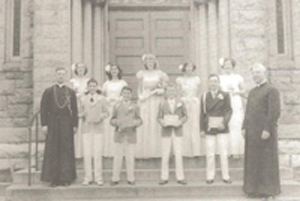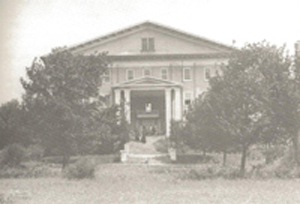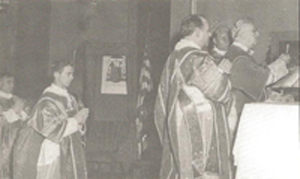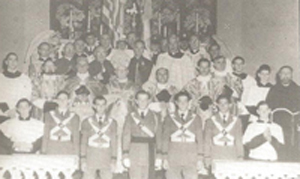Part 5: World War II, a Franciscan Monastery, and the Parish Centennial (1930s-1950)*
The War Years
An indication of the changes of the time during the 1930s was the substitution of bingo parties and card parties for the lawn parties and suppers of earlier years. Serving both as social and fund-raising functions, these occasions were sponsored by the various church organizations.
A military high Mass in honor of the men, both living and dead, of Staunton and Augusta County who served in World War I was offered on November 10, 1935, with the Reverend Arthur J. Taylor of Hot Springs as the celebrant. The Catholic squad of Staunton Military Academy, directed by Major Francis Duggan, formed the guard of honor. Military ushers were Major Louisell, Lieutenant Slattery, Captain Murphy, and Captain Caldwell. Special music was provided by the choir under the direction of Mrs. Margaret R. Croghan, who was organist for fifty years. Other performers were Professor Leo J. Burnicke and Messrs. Paul Roller and James Farrow, violinists; Mr. J. Burnicke of Philadelphia, tenor; and Mr. J. P. Campbell of Staunton, bass. At the Offertory a quartet composed of Mr. and Mrs. Emidio Chiodi, Mrs. Croghan, and Mr. Campbell sang.
Father Crowe returned again in 1937. The congregation was gladdened to see him looking so well when he first returned. But he was not well and retired that same year; Father Emmett P. Gallagher then became the pastor.
In 1938 Father Gallagher, Tommy Johnson, and Joe Johnson drove to Mustoe and locked and secured the doors of the wooden church for the last time. All the religious items were brought to St. Francis.
Known for his affection for children, Father Gallagher would throw coins out the rectory window during school recess. He also had a sense of humor and occasionally would remind the Staunton Military Academy and Augusta Military Academy cadets that even though he did not really expect them to put money in the collection baskets, he hoped that they would not take money out of them.
A little girl who lived near Waynesboro was very sick one afternoon. She screamed with pain in her head. Father Gallagher took her home from school. He said he had had a little sister who had acted just as the child did. His sister had meningitis and died. He remembered his little sister as the child screamed. The child did have meningitis and lost all hearing, but she came back to make her First Communion with the class.
Sister Barbara Golibart described the May Processions at this time. ”The May Processions were quite colorful. There was a little boy in my class who had cerebral palsy, Edward Trainum. His mother made the flower girls’ dresses. They were rainbow colors—two pink, two blue, two yellow, two green, two peach, two orchid. The two page boys were dressed in blue satin. They wore satin knickers and capes, high white socks, and white shoes. They wore matching big hats with real peacock feathers. My mother loaned me the beautiful feathers, which I borrowed many more times.”
On Sunday, May 4, 1941, President Roosevelt visited Staunton to dedicate the Woodrow Wilson Birthplace. Three low Masses were held at 7:00, 9:00, and 11:00 A.M. so that people would have plenty of time to see and hear the President. The next year with the declaration of World War II, the members of St. Francis plunged into a total participation. Pleas of help at the USO or Red Cross were included in the usual Sunday announcements. The Bishop made a special request for funds for the USO. Several ladies assisted the Red Cross; also the whole parish participated in a Red Cross emergency drive. Local needs took second place. For example, the coal collection in 1943 amounted to about five hundred dollars, a drop of three hundred dollars from the year before. However, in 1944 St. Francis participated in a special drive for clothing for liberated Europeans and also paid eight hundred dollars on its remaining debt of two thousand dollars.
In 1941 the Reverend Michael J. Hartigan came as resident and the Reverend John F. McMahon came as assistant. They were a great help to Father Gallagher because of the mission work, the scope of which was further increased when German and Italian diplomats were interned at Ingleside Hotel during 1942. The Catholics among this group heard Mass and received the Sacraments at the hotel. Mrs. Odile Cleveland, a parishioner, recalls that in 1946, after most of the diplomats had been repatriated, those that remained at the Homestead were brought to St. Francis for Mass. The prisoner of war camps in this vicinity further occupied these three priests.
Reminiscent of the priest played by Bing Crosby in Going my Way, Father McMahon was very popular with young people; he was active in training the altar boys and working with the scoutmaster of the Boy Scout troop. A very popular assistant, he received an unexpected eight hundred dollars on his deparrure.
Father Hartigan, on the other hand, was somewhat like the priest played by Barry Fitzgerald. He was born in Ireland, and he missed the kinsfolk and friends he had left behind in responding to the call to serve the spiritual needs of Catholics in Virginia. He was characterized by his good humor and witty speech. Parishioners during his time well remember his announcements about when Masses would be said in the Sisters’ “Shapel” and that at the High Mass on Sunday Mrs. Musser would be the “arrganist.”
Mrs. Catherine J. Musser was an accomplished musician who was much in demand for performances in Staunton. She succeeded Margaret Mitchell, organist under the direction of Mrs. Margaret R. Croghan. Mrs. Musser served as organist at St. Francis for about thirty years, working at various times under the excellent leadership of both Thomas G. DeVito and Gilbert T. Perron. Mrs. Wayne B. Erskine joined her in 1949, and the church had two organists until 1973, when Mrs. Musser died. Mrs. Erskine continued until her retirement in the spring of 1976. She was honored with a surprise retirement party in the school hall.
On May 17, 1943, St. Francis had a special celebration for the 25th Anniversary of Father Kilgalen’s ordination. Then on September 1 representatives of St. Francis parish attended the dedication of Woodrow Wilson Army Hospital and the Woodrow Wilson Post Chapel. Dedicated to the Catholic, Jewish, and Protestant faiths, the Chapel served the Catholics at the hospital throughout the war.

Father Donfred H. Stockert, left, and a graduating class with Father James Gacquin
On Friday, January 12, 1945, the Reverend Edwin J. Lee, one of the assistants, died at the rectory. A solemn funeral Mass was held the following Monday and his body was taken to Richmond for burial. The Reverend Donfred H. Stockert was appointed his successor. Father Stockert had just been assigned to West Point, Virginia, and had not fully unpacked when he was notified that he was needed in Staunton by the next day. When he arrived, Father Gallagher was in a hurry to go to the church. Since Father Stockert had not eaten, Father Gallagher fixed him a snack and told him to eat quickly before the housekeeper returned, implying that she would be angry that he was eating after mealtime. But when the housekeeper arrived, she said, “This young man can’t eat that garbage.” Father Gallagher had to wait while she prepared Father Stockert a proper meal.
Father Stockert was young and strong and very popular with the youth. Once when he was playing ”Monsters,” the favorite game of the time, with some young people, he made a howlng jump off the wall at a young lady, but she was not in the game; he had unintentionally frightened a Mary Baldwin student.
Father Stockert was from the North and liked to ice skate. During a series of cold winters he got the fire department to spray the frozen surface of Lake Tams to make it smooth. Every time he went ice skating, he was accompanied not only by young people from the church, but also by Mary Baldwin students. They were not permitted to skate alone, but if Father Stockert was skating it was okay. Father Stockert remembers one student who told Father Gallagher, “Father Stockert is soooo nice.” He is also remembered for the discussion groups which he led in the homes of the parishioners.

Our Lady of Angels Monastery
A Monastery and a Centennial
Catholicity in St. Francis Parish was enhanced with the establishment in 1945 of Our Lady of the Angels Monastery in the old Manch’s School of Music building in College Park. This monastery, dedicated by the Apostolic Delegate Giovanni Cicognani on September 20, 1945, was used initially as a seminary for the training of young men for the Capuchin priesthood. There were twenty-six students, nine studying theology and seventeen studying philosophy. The first group received sacred orders on March 10, 1946, from the Bishop in St. Francis Church. In 1954 the theology and philosophy students were sent to Geneva and Beacon, New York, respectively, and the monastery became a one-year novitiate for the order. In early 1950 a three-day lay retreat for Catholic men from the Valley section of the Holy Name Society was held at the Capuchin monastery. The services were opened under the supervision of Father Aquinas, S.A., of the Catholic University of America.
On July 29, 1956, Auxiliary Bishop Hodges blessed a new chapel at the monastery; at that time eleven young men received the habit of the order. In 1961 the monastery became a high school for young men preparing for the Capuchin Order. In 1966, the young men were transferred to Saint Francis School in Andover County, New Jersey, since the monastery lacked certain needed equipment. After that time, activity at the monastery became diminished and finally ceased in 1970. The eighty-room building and accompanying 12.75 acres were sold to Knopp Brothers for development.
On August 14, 1946, St. Patrick’s in Lexington was established as a separate parish with the Reverend Aloys G. Selhorst, C.P.P.S., as the first resident pastor. In the same year Waynesboro was also made a separate parish with Father Walsh as its pastor (Holland, 1953).
In September, 1947, Father Gallagher was transferred to St. Rita’s Church in Alexandria, where he served until his retirement in 1967. On February 10, 1961, he was named a domestic prelate. He died in 1968 at the age of seventy-one. The Reverend James P. Gacquin replaced Father Gallagher at St. Francis.
Father Gacquin was born in County Roscommon, Ireland, on November 19, 1896, one of seven children of Thomas and Mary Gacquin. In studying for the priesthood, he was educated at All Hallows College in Dublin, Ireland, and after completing his theological studies was ordained on June 20, 1920, by Bishop Robin Todd. On November 1 of that year he came to America and was assistant pastor at St. Joseph’s Church in Petersburg. He remained there until 1927, when he became the pastor of St. James Catholic Church at Hopewell, where he spent twenty fruitful years prior to his transfer to Staunton.
Father Gacquin was known for his enthusiasm in winning souls to Christ and leadership in promoting charitable works. Possessing administrative abilities, he was also noteworthy in promoting lay and religious activities. Father Gacquin further distinguished himself as a person of great public spirit because of his sincere interest in the welfare of all members of the community. Some parishioners remember the deep bass drawl in which he began the prayer before Communion, ”Deeeeeemini non sum dignus.”
In July 1949, Father Gacquin was appointed Vicar Forane of the Valley Deanery. One of his more memorable acts was preparing St. Francis for its centennial, which began on October 15, 1950. He oversaw an impressive redecoration program carried out by Robbie Robbins of New York under the direction of T. J. Collins and Son. New light fixtures were installed, a gift from Miss Annie Fallon, a teacher in the Staunton Public Schools from 1880-1912.

Elaborate and extensive services and programs took place marking the first hundred years of St. Francis Parish. In this photo Bishop Peter L. Ireton opened the observance with a solemn pontifical Mass.

The bishop and other visiting clergy and the cadet honor guard.
Bishop Peter L. Ireton opened the celebration with a Solemn Pontifical Mass. A color guard of seventy cadets from Staunton Military Academy and Augusta Military Academy led the procession into the church. The Mass was sung by members of St. Francis Parish choir and students from the Capuchin monastery. The organist was Catherine Musser. Monsignor William J. Meredith preached an impressive sermon on what St. Francis Church had meant to Staunton. He emphasized that it had inculcated a strong respect for civil and religious authority and a desire to use one’s talents and abilities for the glory of God and the welfare of all.
The solemnity of the Mass was intensified as the consecration drew near. All of the cadets stood at attention while four of the young men marched to the center aisle where they presented arms while two buglers and a drummer played taps. Complete silence followed as the host and chalice were raised. That afternoon a sectional meeting of the Holy Name Society was held, followed by Benediction and concluding with refreshments.
A High Mass was celebrated the next day by the Very Reverend Robert O. Hickman for the deceased priests and sisters of the parish with singing by the choir from Our Lady of Angels Monastery. That evening the school children presented a pageant in five episodes at Mary Baldwin College, telling the story about America’s last one hundred years. The pageant was written by members of the faculty and music was under the direction of Mrs. Wayne Erskine and Miss Virginia Marino. Costumes were furnished by the Doll House and Mrs. Vinton. John Kivlighan and Mary Cecilia Collins sang a duet.
On Wednesday a Mass was celebrated by Monsignor Meredith for the deceased members of the congregation. That evening the celebration closed with a banquet held at Stonewall Jackson Hotel. Approximately two hundred persons attended. During the evening music was provided by Mr. and Mrs. Joe Glease of Waynesboro. Dr. Howard M. Hanna, chairman of the building fund committee, reported that ten thousand dollars had been paid on the twenty-five thousand dollar debt incurred as a result of recent work on the interior of the church, and that twenty-two thousand dollars had been pledged.
Bishop Ireton recalled three significant Papal pronouncements from 1850-1950 dealing with doctrines of faith: the Immaculate Conception, Papal Infallibility, and Mary’s Assumption into Heaven. The Bishop made it very clear that the pope is human and capable of making mistakes. The Roman Catholic world recognizes his infallibility only on matters of faith and morals. The celebration ended with a benediction by Father Egan.
_______________
*This history of Staunton’s Catholic parish is taken from A History of St. Francis of Assisi Parish, Staunton, Virginia: Celebrating 150 Years, 1845-1995 by Hampton H. Hairfield, Jr., Elizabeth M. Hairfield, and Jane E. Smith (published in 1995) and used with permission.
